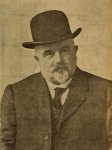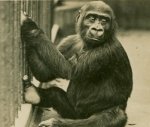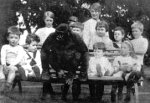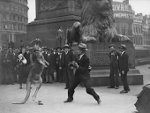

John Daniel Hamlyn (1858-1922)
 Like his near-neighbours Jamrachs
Taunton-born John Daniel Hamlyn traded in wild animals from
his premises at 221 St George's Street, described as a 'naturalist'. The fascinating 1917 editions of his Menagerie Magazine find him offering for sale, perhaps in some desperation during the war years, a quiet 8-year old female Indian
elephant for the bargain price of £200. He is said to be the inventor of the 'chimpanzees' tea party' - see below. At the Old Bailey in
1890 his assistant Thomas Cross was sentenced to twelve months' hard labour for fraudulently cashing postal orders to the value of £13.
By the time of the First World War Hamlyn was a Stepney borough
councillor (and vice-chairman
of the Board of Guardians for the workhouse), a life governor of the
New Finsbury Park Boys' Institution and a member of the Stepney
Military Service Local Tribunal. He provided animal specimens for
research on tuberculosis, and for army experiments during the war. Here
are some accounts of his activities:
Like his near-neighbours Jamrachs
Taunton-born John Daniel Hamlyn traded in wild animals from
his premises at 221 St George's Street, described as a 'naturalist'. The fascinating 1917 editions of his Menagerie Magazine find him offering for sale, perhaps in some desperation during the war years, a quiet 8-year old female Indian
elephant for the bargain price of £200. He is said to be the inventor of the 'chimpanzees' tea party' - see below. At the Old Bailey in
1890 his assistant Thomas Cross was sentenced to twelve months' hard labour for fraudulently cashing postal orders to the value of £13.
By the time of the First World War Hamlyn was a Stepney borough
councillor (and vice-chairman
of the Board of Guardians for the workhouse), a life governor of the
New Finsbury Park Boys' Institution and a member of the Stepney
Military Service Local Tribunal. He provided animal specimens for
research on tuberculosis, and for army experiments during the war. Here
are some accounts of his activities:| Chimpanzee -
The Wild Beasts of the World (1909) The most remarkable Chimpanzee I have seen ... is one which was recently for some months in the possession of the well-known animal dealer, Mr. J. D. Hamlyn, who has made a specialty of anthropoid apes. This animal, Peter by name, was kept tied up in a living-room, but was often let out, and regularly had his meals with the family; and I have often had the pleasure of sitting at table with him. His behaviour was exactly that of a rather naughty child; his owners assured me that he understood all that was said to him, and certainly his behaviour went far to bear out this statement. I have seen him, on being told to do so, fetch whisky and soda and pour out a 'peg', bring his master's slippers and put them on, set up a chair he had pulled over, and so forth, besides coming at call and kissing. He had, moreover, ideas of his own; when given a note-book and a pencil, he would scribble on one page after another just as a child does, and he would steal any key he could get hold of and try to unlock the padlock of his chain with it. Another original idea of his was to get hold of a whip or a strap, and therewith thrash another Chimpanzee, Pat, of his own size, who, being spiteful, was always tied up. Peter tyrannised over Pat very much, tried to shut him in his box, and always kept him under whenever possible; yet on occasion he would side with him. Peter had previously been in a private owner's house for some months before he came into Mr. Hamlyn's possession; but a previous specimen Mr. Hamlyn had, Pansy, was trained on his premises throughout, and was as civilised in his behaviour as Peter, though not so widely accomplished. He met his death by taking a fatal chill, owing to a practice he had of taking a sponge and washing the stairs - a proceeding in which, needless to say, he received no encouragement. |
 John Daniel, the 'civilised gorilla'
John Daniel, the 'civilised gorilla' In 1917 Hamlyn acquired from a sea captain an infant male lowland gorilla,
captured in Gabon near the Cameroon border after his parents were shot
by French officers. He sold it to the department store Derry &
Toms, for exhibition and sale. Around Christmas 1918 Major Rupert Penny
bought him for £300; the gorilla was suffering from pneumonia, so was kept in
a specially-constructed hut in his garden, the walls lined with muslin
to keep out draughts, until he had recovered, which he speedily did. He
was then put in the care of his sister, Miss Alyce
Cunningham, at their shop and home at 15 Sloane Street and also at
their country residence in Uley, Gloucestershire (where he went for
walks with the children of the local school and attended the annual
fair - right). In London, John Daniel (aka Johnny Gorilla and Sultan) lived the
life of a gentleman, with tea at 5pm and coffee after dinner - and also
three glasses of whiskey or sherry or port each day, which Miss
Cunningham believed necessary to stave off melancholia. Some accounts
say he slept in a cage in the shop basement, but others that he had his
own bedroom, with an electric radiator. With a mental age of a 3-4 year old child, he learned to use light switches and the
lavatory, make his bed and do the washing-up, and understood simple
commands. Dressed as a child, napkin on lap, he sat at table to eat
high tea with Miss Cunningham's young niece and other specially-invited
children, after which they played together (which in later years they regarded as entirely natural). Each morning Alyce took him
in a taxi to the London Zoo for a few hours, where he became famous.
Apparently he preferred the
attention of females - he looked bored in the presence of men, and
would
urinate towards them from his cage, but his eyes would light up if a
young woman came along, though he reacted badly to any wearing fox
furs. She later wrote about him and his 'successors' (Windsor Magazine 1930, p200):
In 1917 Hamlyn acquired from a sea captain an infant male lowland gorilla,
captured in Gabon near the Cameroon border after his parents were shot
by French officers. He sold it to the department store Derry &
Toms, for exhibition and sale. Around Christmas 1918 Major Rupert Penny
bought him for £300; the gorilla was suffering from pneumonia, so was kept in
a specially-constructed hut in his garden, the walls lined with muslin
to keep out draughts, until he had recovered, which he speedily did. He
was then put in the care of his sister, Miss Alyce
Cunningham, at their shop and home at 15 Sloane Street and also at
their country residence in Uley, Gloucestershire (where he went for
walks with the children of the local school and attended the annual
fair - right). In London, John Daniel (aka Johnny Gorilla and Sultan) lived the
life of a gentleman, with tea at 5pm and coffee after dinner - and also
three glasses of whiskey or sherry or port each day, which Miss
Cunningham believed necessary to stave off melancholia. Some accounts
say he slept in a cage in the shop basement, but others that he had his
own bedroom, with an electric radiator. With a mental age of a 3-4 year old child, he learned to use light switches and the
lavatory, make his bed and do the washing-up, and understood simple
commands. Dressed as a child, napkin on lap, he sat at table to eat
high tea with Miss Cunningham's young niece and other specially-invited
children, after which they played together (which in later years they regarded as entirely natural). Each morning Alyce took him
in a taxi to the London Zoo for a few hours, where he became famous.
Apparently he preferred the
attention of females - he looked bored in the presence of men, and
would
urinate towards them from his cage, but his eyes would light up if a
young woman came along, though he reacted badly to any wearing fox
furs. She later wrote about him and his 'successors' (Windsor Magazine 1930, p200):Alyse
Cunningham was
finding John Daniel increasingly difficult to keep. In just three years
he had
grown from a 32lb. infant to a 110lb. juvenile, 3' 4" tall. So they
sold him to the American animal dealer John Benson for $20,000,
expecting that he would be housed in a Florida park; in fact, they had
been tricked, and he was destined for Ringling Brothers / Barnum and
Bailey's circus. He arrived in New York and spent two weeks at
Ringlings' Zoo in Madison Square Gardens, but was clearly unsettled and
developed pneumonia. Miss Cunningham was sent for, and set sail, but he
died before her arrival; he was 4½. His body was exhibited at the
American Museum of Natural History, and then dissected. Miss Cunningham
wrote a paper for the Zoological Society Bulletin A gorilla's life in civilization (1921), and W.E. Le Gros Clark a technical paper Laterality of function in Apex
(1927), based on the conspicuous asymmetry found in the anteposterior
extent of the brain hemispheres, with a larger size on left side (which
some thought explained why John Daniel was right-handed).
There
were two more John Daniels - but this time clearly in the ownership of
Miss Cunningham. John Daniel II was a 4-year old, also from Gabon, with
a clumsy shuffle; she acquired him in 1924 and he shared a stateroom
with her on the maiden voyage of the steamship Deutschland
to the USA, and thereafter in hotel rooms and railroad sleeping cars,
during their extensive tours of the USA. He died in 1927.
 Boxing Kangaroo - Edward Henry Bostock Menageries, Circuses and Theatres (1927) part 1, p125 Boxing Kangaroo - Edward Henry Bostock Menageries, Circuses and Theatres (1927) part 1, p125... The kangaroo's performance on the second night was equally successful, and then agents began to buzz around me like bees asking me for the open dates for this wonderful turn. On the following day, however, I had to leave London to go to Bolton to attend to some matters in connection with my No.3 Menagerie and so I deputed the late Mr. J. D. Hamlyn, naturalist, to watch my interests in the boxing kangaroo. Judge of my surprise when two days later (on New Year's Eve) I received a telegram at Bolton from him informing me that the kangaroo had gone lame, that a veterinary surgeon was attending him, and that he was consequently unable to appear at the show in the evening. I naturally thought that the kangaroo had overstrained himself and that with a few days' rest he would be ready for the stage again. It was, therefore, somewhat of a surprise, indeed shock, when I received a second telegram two days later announcing the death of the animal. Thereupon I hastened back to London to inquire into the cause of his death, and this I was not long in ascertaining. I found that the kangaroo had run a splinter of wood into his leg, and that this had produced lockjaw. That was the end of my first boxing kangaroo, who had enjoyed conspicuous success for the brief season of four nights ... left - photographer Fred Morley takes on Aussie, the boxing kangaroo, in Trafalgar Square, 1931. It has become an Australian national symbol. |
Back to Ratcliff Highway | Back to St George's Street Directory 1921